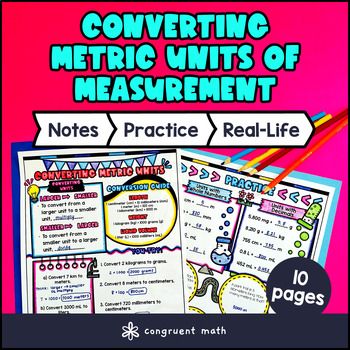Want more ideas and freebies?
Get my free resource library with digital & print activities—plus tips over email.
Join for Free Resources →
$4.25
Ever wondered how to teach converting metric units of measurement in an engaging way to your 4th and 5th grade students?
In this lesson plan, students will learn about metric unit conversions and their real-life applications. Through artistic, interactive guided notes, checks for understanding, a color-by-code activity, and a maze worksheet, students will gain a comprehensive understanding of converting metric measurements.
The lesson culminates with a real-life example that explores how this math skill is used in everyday situations, helping students see the value beyond the classroom.

$4.25
After this lesson, students will be able to:
Before this lesson, students should be familiar with:
As a hook, ask students why it might be important to understand how to convert metric units of measurement in everyday life. For example, you might prompt them to think about cooking, measuring distances for travel, or buying fabric for a project. Refer to the last page of the guided notes for real-life examples and the FAQs section for additional ideas to spark student interest.
Use the first page of the guided notes to introduce the units of the metric system (such as millimeters, centimeters, meters, and kilometers for length; milliliters and liters for volume; and grams and kilograms for mass). Walk through the basic structure of the metric system, emphasizing how each unit relates to the others through powers of ten. Highlight how moving one step up or down in units means multiplying or dividing by 10, 100, or 1000. Refer to the FAQ below for detailed guidance on explaining these relationships and common misconceptions students may have.
Use the second page of the guided notes to teach the process of converting between metric units. Walk students through the steps for converting a measurement from one unit to another, using examples that include whole numbers as well as decimal values. Emphasize the use of place value and how to move the decimal point correctly when converting to larger or smaller units. Refer to the FAQ for tips on addressing frequent student questions such as how to know which direction to move the decimal and how to check their work for accuracy.
If during the guided note checks for understanding you find certain students struggling with the conceptual understanding of unit relationships or the mechanics of decimal movement, pull them aside for targeted reteaching. Meanwhile, students demonstrating proficiency can start working on the practice exercises to reinforce their skills independently.
Have students practice converting metric units of measurement using the color by code worksheet. Walk around to answer student questions.
Fast finishers can dive into the maze activity for extra practice. You can assign it as homework for the remainder of the class.
Bring the class back together, and introduce the concept of using metric unit conversions in everyday life, such as measuring distances when traveling, cooking recipes that require precise measurements, or understanding the volume of liquids in containers. Encourage students to think about how switching between units like centimeters to meters or milliliters to liters is helpful beyond the classroom. Refer to the FAQ for more ideas on how to teach it!
If you’re looking for digital practice for converting units of measurements, try my Pixel Art activities in Google Sheets. Every answer is automatically checked, and correct answers unlock parts of a mystery picture. It’s incredibly fun, and a powerful tool for differentiation.
Here’s 1 activity to explore:
The metric system is a decimal-based system of measurement used worldwide. It includes units such as meters for length, liters for volume, and grams for mass.
To convert between metric units, you multiply or divide by powers of 10 depending on whether you are converting to a larger or smaller unit.
Move the decimal point:
The basic metric units are:
Length: meter (m) Mass (weight): gram (g) Volume: liter (L)
The metric system is easier because it is based on multiples of 10, which means you only need to move the decimal point to convert units. Customary units like inches to feet require memorizing different conversion factors.
Converting with whole numbers often involves simple shifts of the decimal point, while decimals require you to carefully move the decimal to preserve accuracy.
Important:
To convert kilometers to meters, multiply the number of kilometers by 1,000 because 1 kilometer equals 1,000 meters.
Example: 3 km x 1,000 = 3,000 meters.
Metric conversions are used in many real-life situations including:
Cooking: measuring ingredients in liters and grams. Science: measuring distance, volume, and mass in experiments. Travel: calculating distances in kilometers and meters.
Guided notes support students by:
Providing structure: Step-by-step instructions. Engaging learners: Interactive elements like doodles and coloring. Making learning visual: Helps memory and understanding. Checking understanding: Includes checkpoints for students to self-assess progress.
Get my free resource library with digital & print activities—plus tips over email.
Join for Free Resources →